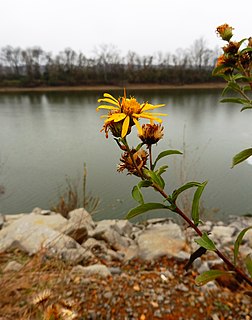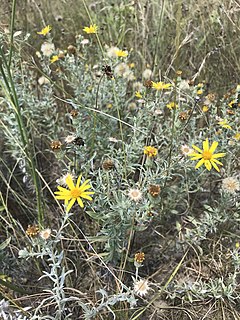
Astereae is a tribe of plants in the family Asteraceae that includes annuals, biennials, perennials, subshrubs, shrubs, and trees. Plants within the tribe are present nearly worldwide divided into 170 genera and more than 2,800 species, making it the second-largest tribe in the family behind Senecioneae. They are found primarily in temperate regions of the world.

Heterotheca, are North American plants in the family Asteraceae.

Cycladenia humilis is the sole member of the monotypic genus Cycladenia. Known by the common name Sacramento waxydogbane, it is an uncommon plant native to the southwestern United States. Collections have mostly been from California, although the species has also been reported from Utah and Arizona, mostly on gypsum soils. It is found at some elevation in several mountain ranges in the region. One of the four varieties of this plant, called the Jones waxydogbane, is considered a threatened taxon. This is a fleshy perennial herb with dull green leaves and pinkish lavender flowers. The flowers begin as rolled tubes shaped like pea pods and then open into colorful funnel-shaped blooms.

Heterotheca grandiflora is a species of flowering plant in the family Asteraceae known by the common name silk-grass goldenaster or telegraphweed. It is native to the southwestern United States and northwestern Mexico, but it can be found in other areas as an introduced species, such as Hawaii. It is often a roadside weed even where it is native.
Heterotheca oregona is a species of flowering plant in the family Asteraceae known by the common name Oregon false goldenaster. It is native to the west coast of Canada and the United States in British Columbia, Washington, Oregon, and California as far south as Los Angeles County.

Heterotheca sessiliflora is a species of flowering plant in the family Asteraceae known by the common name sessileflower false goldenaster. It is native to California, Sonora, and Baja California.
Heterotheca monarchensis is a rare species of flowering plant in the family Asteraceae known by the common names monarch goldenaster and sequoia false goldenaster. It is endemic to Fresno County, California, where it is known from only one location near Boyden Cave in the Kings River Canyon. It grows in the limestone cliffs of this Sierra Nevada river canyon, along with a few other rare local endemics. The plant was discovered in July, 1995, and described to science as a new species in 1996.

Heterotheca shevockii is a rare species of flowering plant in the family Asteraceae known by the common names Kern Canyon false goldenaster and Shevock's goldenaster. It is endemic to California in the United States, where it is known only from Kern County. It grows along a 21-mile stretch of the Kern River.

Bradburia pilosa, the soft goldenaster, is a North American species of flowering plants in the family Asteraceae, native to the south-central United States, primarily the southeastern Great Plains and lower Mississippi Valley, in the states of Texas, Oklahoma, Kansas, Missouri, Arkansas, Louisiana, Tennessee, Mississippi, and Alabama. Additional populations are reported farther east but these appear to be introductions. Its habitats include disturbed roadsides and pine-oak-juniper woods.

Heterotheca subaxillaris, known by the common name camphorweed, is a North American species of flowering plant in the family Asteraceae. It is widespread across much of the United States as well as Mexico and Belize.

Heterotheca camporum, known by the common name lemonyellow false goldenaster, is a North American species of flowering plant in the family Asteraceae. It is found only in the central United States, primarily the Ozarks, the Cumberland Plateau, and the middle Mississippi Valley. There are reports of additional populations in the Northeast, the Southeast, and in the Great Lakes region, but these appear to be waifs or naturalizations.
Heterotheca barbata, the Spokane false goldenaster, is a very rare North American species of flowering plant in the family Asteraceae. It has been found only in the northwestern United States, in eastern Washington and northern Idaho.
Heterotheca fulcrata, known by the common name rockyscree false goldenaster, is a North American species of flowering plant in the family Asteraceae. It has been found in northern Mexico and in the western United States.

Heterotheca canescens, common name hoary goldenaster, is a North American species of flowering plant in the family Asteraceae. It has been found in northern Mexico and in the Great Plains of the central United States.
Heterotheca marginata, the Sonora false goldenaster, is a rare North American species of flowering plant in the family Asteraceae. It grows in Arizona in the southwestern United States. It has been found in only three counties in the south-central part of the state: Maricopa, Pinal, and Gila.
Heterotheca pumila, the alpine goldenaster, is a North American species of flowering plant in the family Asteraceae. It grows in alpine and subalpine regions in the mountains of the western United States. It has been found the Rocky Mountains in Wyoming, Colorado, Utah, and New Mexico.

Heterotheca rutteri, the Huachuca goldenaster or Rutter's false goldenaster, is a rare North American species of flowering plant in the family Asteraceae. It has been found only in the Huachuca and Santa Rita Mountains of southern Arizona and northern Sonora.
Heterotheca stenophylla, called the stiffleaf goldenaster, is a North American species of flowering plant in the family Asteraceae. It grows on the Great Plains of the central United States from South Dakota south to Texas and New Mexico.
Heterotheca viscida, called the cliff goldenaster, is a North American species of flowering plant in the family Asteraceae. It grows on cliffs and ledges in mountainous regions. It grows in the southwestern United States, primarily in Arizona, New Mexico and southern Texas with reports of isolated populations in Nevada, southeastern Idaho, and southeastern Colorado.
Heterotheca zionensis, the Zion goldenaster, is a North American species of flowering plant in the family Asteraceae. It grows in Utah, Arizona, New Mexico and western Texas. The plant has also reportedly been found in southeastern Idaho and northwestern Colorado, but these are most likely introductions.









